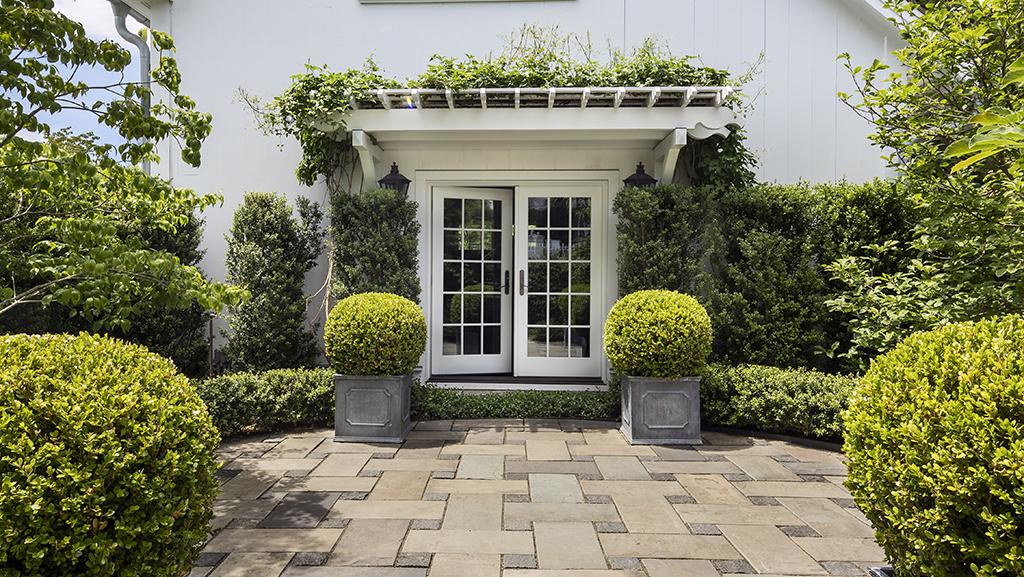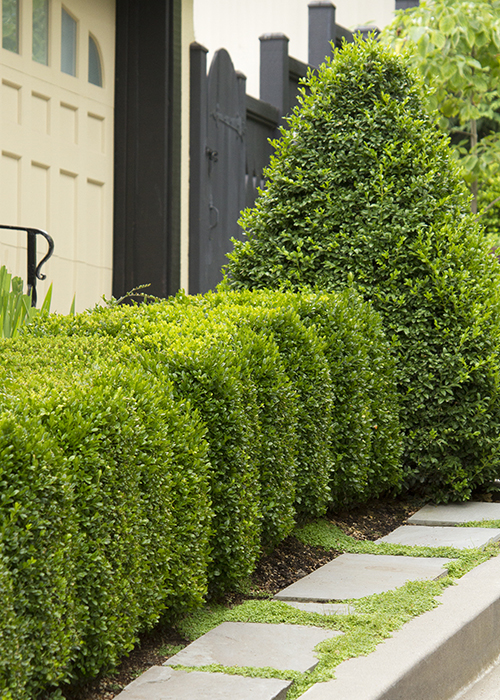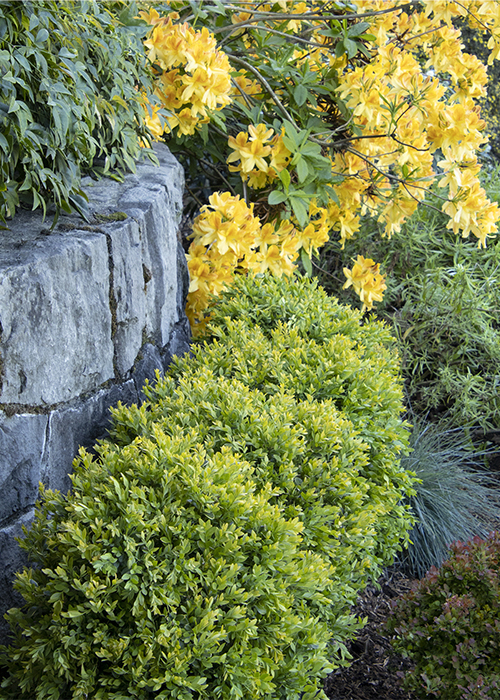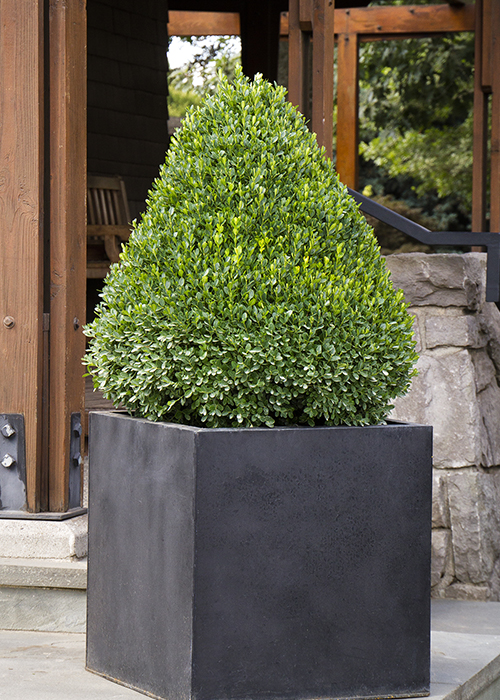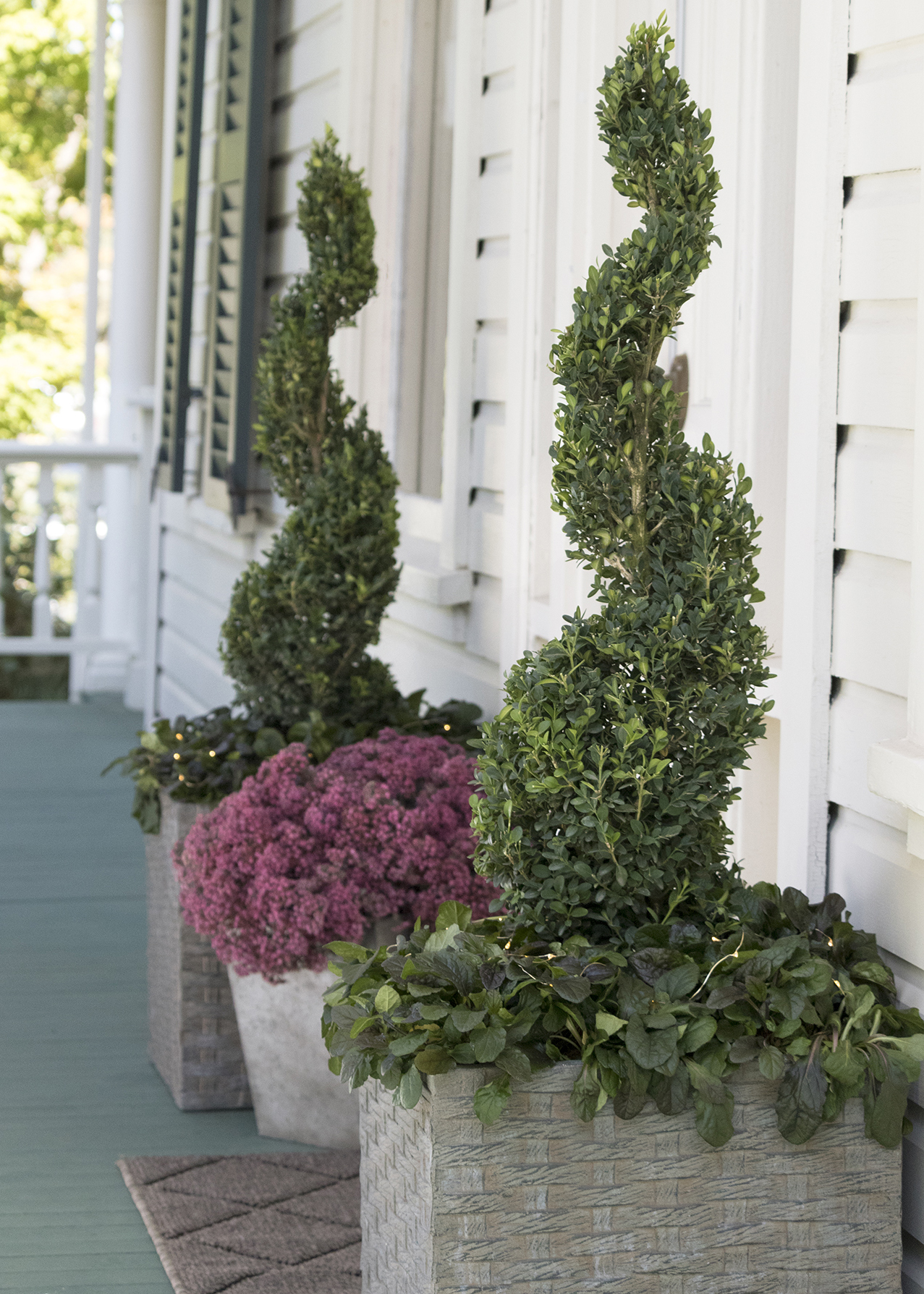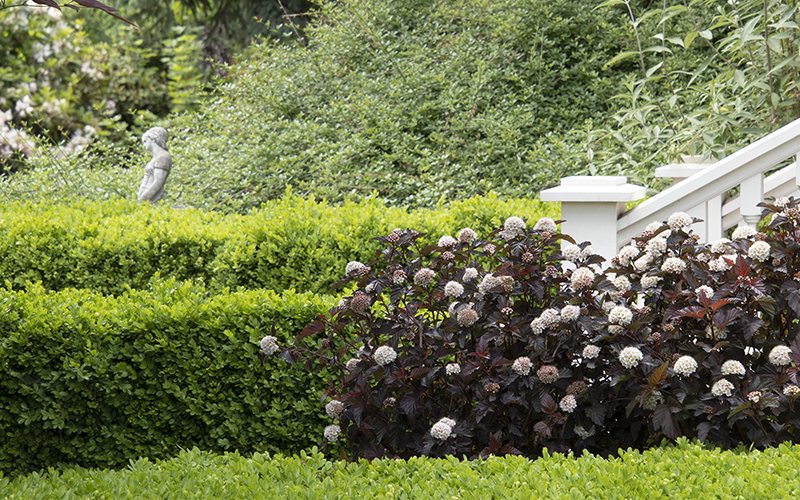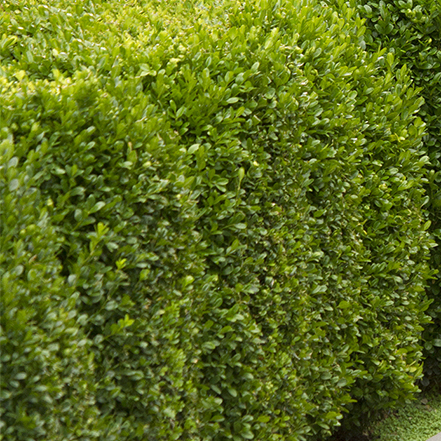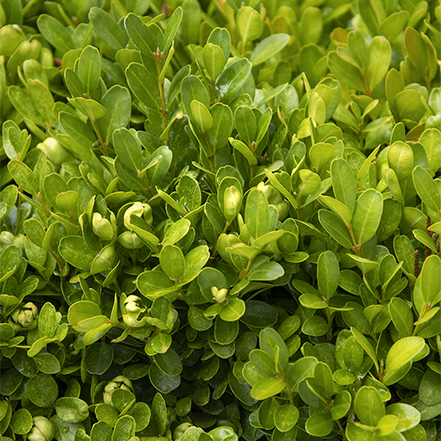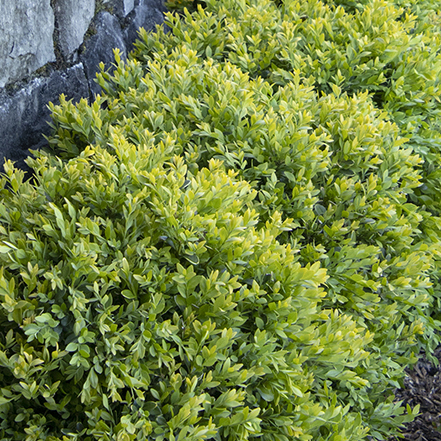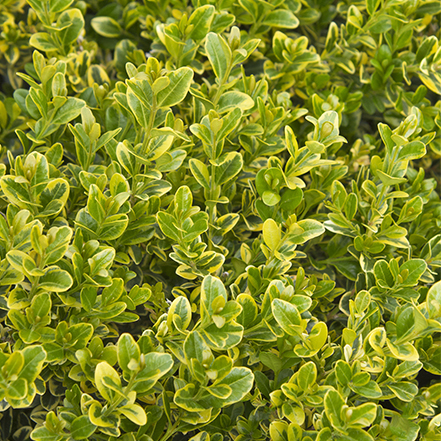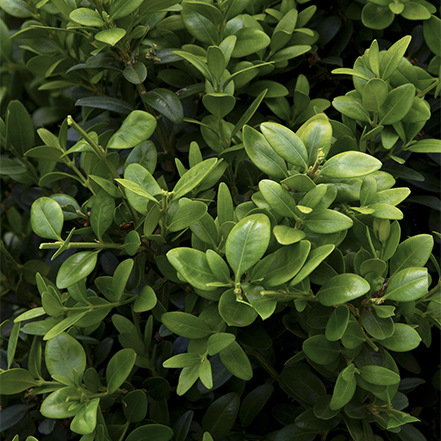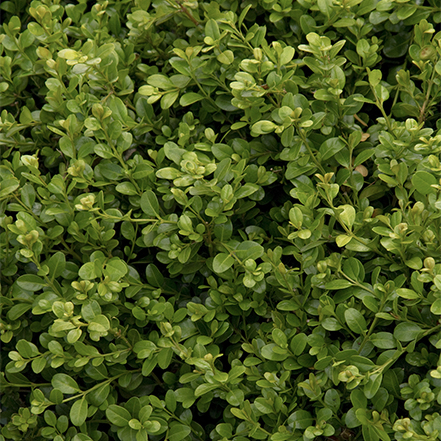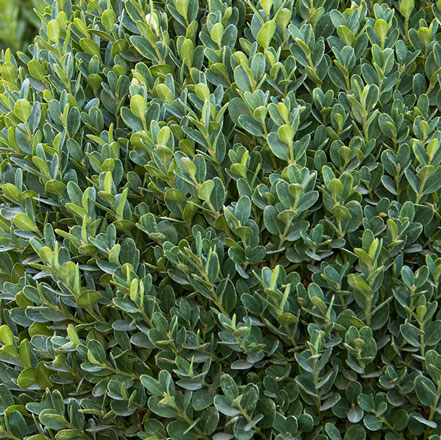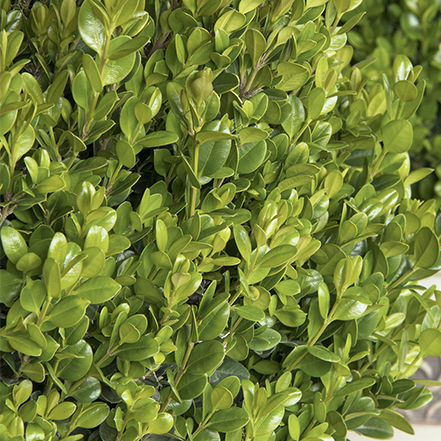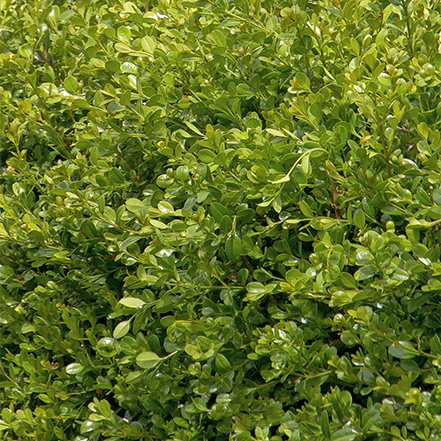Boxwood shrubs have a subdued elegance that shines in every season. Their evergreen presence offers structure and a unifying element in the garden. No matter your garden style — formal, cottage, or contemporary — the ever-adaptable boxwood looks beautiful when planted as a specimen, mass planting, or hedge. If you express your garden style in containers, boxwoods can thrive potted up as a distinct feature or provide a backdrop for annuals, perennials, and seasonal decorations.
Low-maintenance, as well as deer and rabbit resistant, many boxwoods will thrive for you in growing zones 4-9. (Determine your growing zone hereand see our favorite boxwoods at the bottom of the page). If you live in an area that experiences cold temperatures during winter, protecting your boxwoods against winter damage starts with growing healthy and vigorous plants throughout the season. Here's how to grow healthy boxwoods and protect them from winter burn or damage.
Boxwood Winter Care in the Garden
Generally, boxwood will be less likely to suffer winter damage if it is hardy for the planting zone; appropriate for the environmental conditions, and properly planted and watered. In short, follow the golden rule of gardening: right plant, right place! The following tips will help you find the right place for boxwood in your garden and start you on the best course for protecting boxwoods from winter damage.
General Boxwood Care
Boxwood Soil Needs
- Boxwood is tolerant of a range of soil types, but it must drain well. Planting boxwood in wet soils will contribute to root rot.
- Boxwood prefers a soil pH of 6.5 (slightly acidic) to pH 7.2 (slightly alkaline). For optimal plant growth, test soil pH and nutrients before planting and every 3 years afterward.
Boxwood Water and Light Needs
- Boxwood is sensitive to drought. During dry spells, including fall and winter, plants will benefit from receiving one inch of water per week. Keep watering until the ground freezes.
- Boxwood prefers the morning sun. Damage from mid- to late-afternoon sun can be a problem in both winter and summer. In northern climes, light shade in winter is more important than in summer because leaf scorch occurs in the winter sun.
Where and How to Plant Boxwood
- When planning, prevent size and placement mistakes by researching the growth habit of your selected boxwood cultivar. Space plants with enough room to grow to maturity.
- Remove your plant from the nursery pot, and use your hand or soil knife to “tickle” the root ball to gently pull and tease the roots to help free them from growing in a circle. If the root ball is compacted you may have to use pruning shears to trim off the bottom to loosen the roots.
- The planting hole should be twice as wide as the root ball but not too deep—boxwoods have shallow roots. Leave 2” of the root mass exposed above the soil line. Cover root mass but not the base of the shrub with a 1” summer layer of organic mulch (leaf or wood).
How to Avoid Boxwood Winter Burn or Other Winter Damage
- Plant your boxwoods in protected sites. The north or east side of your garden is preferable. While not optimal, southern or western exposure can work if there is a nearby windbreak or tree canopy providing shade. A structural barrier such as a solid fence or wall can also serve as a windbreak.
- If not already ideally located protect existing plants from winter burn and sun exposure in winter with burlap. Set up after the first hard frost.
- While snow can be a wonderful insulator for plants, heavy loads should be gently brushed off from the tops to prevent breakage. Protect boxwoods from snow and ice damage by wrapping them in burlap (loosely, to allow for airflow) or plastic wildlife netting. Tying up mature boxwoods with twine will ensure that heavy snow loads will slide off and not break branches.
- Before winter, remove any tender late-season new growth and weak stems to reduce stem injury. (Use the clippings to create a boxwood wreath or a winter-themed window box.)
- Sanitize gardening tools used in caring for boxwoods with 70% isopropyl alcohol (rubbing alcohol) to limit the spread of any pests or diseases.
- Once the ground is frozen add a winter layer of mulch (up to 2-3”) to help keep moisture at the roots. Again, be careful not to cover the base stem of the shrub.
- Consider using an anti-desiccant to protect boxwoods from drying out in the winter wind. Apply before temperatures are reliably below 40 degrees.
Overwintering Boxwoods in Containers
With their glossy evergreen leaves, many boxwood varieties make ideal container plants. Whether it is shaped and manicured or in its natural form, an attractively potted boxwood is a welcoming sight around the home. Their beauty and charm can be especially eye-catching in winter when placed at the front door or along an entry path.
The plant's hardiness rating is based on a plant in the ground; an above-ground container is more exposed to the winter air and therefore more susceptible to fluctuating temperatures. When choosing a boxwood that is to be containerized in an area that experiences freezing temperatures select a variety that will tolerate at least two growing zones colder than normal—the more cold-hardy the plants, the better they will perform
The following tips will help you be successful with overwintering potted boxwoods:
Container Selection
- When choosing a container, size matters. The container must be wider than the diameter of the root ball. A good gauge to follow is that your pot should be as wide as the plant is tall. (Boxwood roots grow shallowly and wide.) Larger pots provide more insulation to the roots, which are not as hardy as the plant’s top.
- In addition to selecting the color, style, and size look for thick, insulated, frost-proof pots with good drainage.
- When placed on hard surfaces like concrete, raise pots on feet to provide good drainage. Avoid using saucers that will collect water and freeze. Otherwise, place pots in the garden on the soil.
- If you’re using a self-watering container, make sure it is the type that safely channels the excess water out of the container and doesn’t leave the plant's roots soaking in water.
Planting your Container
- Plant the pot during the growing season (warmer weather) to allow the roots to mature. A plant with mature roots will gradually get used to the cold and will tolerate winter stress better.
Line the bottom of your pot with porous landscape fabric that will allow water to drain but keep the potting mix in.
Fill the pot with a well-draining potting mix. Don’t add gravel or any other fill that is not soil as it contributes to root damage and not better drainage. (Learn more about this erroneous practice here, then share this myth-busting tidbit with your gardening friends.)
Follow the same removal instructions from the nursery pot as if planting in the ground
Place enough soil in the bottom so that the top of the root ball sits an inch below the rim of the pot. Center plant on top and continue adding more potting soil around the root ball, tamping down as you go.
After watering in and allowing the plant to settle, add a 2” layer of organic mulch (leaf or wood) at the base of the plant. Mulching helps preserve soil moisture and moderates soil temperatures.
The Right Place for your Boxwoods in Containers
- Place planters in groups. Putting them together increases the mass and volume of insulation which protects them from cold. (It also simplifies care and watering.)
Boxwoods in containers also do best with a northern or eastern exposure where conditions are typically shadier.
Protect your potted plants from drying wind and harsh sunlight with anti-desiccant spray. Apply before temperatures are reliably below 40 degrees.
Cold Weather Care for Boxwoods in Containers
- For USDA Zone 4-6, well-hydrated plants will survive the cold better. Check plants weekly so they do not dry out. Watering just before a freeze will allow the water to heat your plants as the temperature drops.
For USDA Zones 7-11, hard freezes may not be a concern. However, watering before a cold snap will protect your plants from colder temperatures.
When unusually low temperatures are forecast, be sure to add extra insulation to the root zone by wrapping your container in bubble wrap or heavy cloth.
Unseasonably warm temperatures may cause a flush of new, tender root growth and leaf buds. Be prepared to cover the pot and also the top of the plant when the cold temps return.
Be sure to remove coverings from the plant during the day when temperatures heat up.
Boxwood Care in Early Spring
No matter how well you’ve sited or cared for your boxwood, some winters are hard on plants and damage can occur. Late winter or early spring is a good time to evaluate your boxwood for signs of winter damage or disease. The two most common post-winter problems are yellowing foliage and dead and reddish-brown stems.
If you live in an area with extreme temperatures during winter, boxwood foliage can sometimes turn yellow. This is most often due to winter burn.
How to Care for Boxwoods With Winter Burn or Other Damage
If plants have dead stems, remove these stems by cutting them back to live wood. On plants where the foliage has turned a reddish brown, delay drastic pruning in the spring until after new growth has started.
Very often plants that are fed and given sufficient moisture will produce new foliage and by the end of the spring, the injured foliage will fall and be replaced by the new foliage.
In USDA Zones 7-11, boxwoods can be fertilized in late February, and in USDA Zones 4-6 late March is usually an ideal time. If you’re gardening organically, the best fertilizer is bone meal or dried cow manure. A balanced fertilizer such as a 10-10-10 can be applied to the soil surface when there is sufficient moisture so as not to cause root burn.
Do not confuse winter damage with the dreaded boxwood blight caused by the pathogen Calonectria pseudonaviculata. Currently, boxwood blight has been found in about twenty states from Maine to Georgia. The pathogen does not show up in your landscape naturally; it is often introduced via infected plants. If you’d like to learn how to identify boxwood blight, check out the pictures and info provided by the Virginia Cooperative Extension.
Winter-damaged plants often show a ‘snowline’. The exposed parts of the plant will be brown while the foliage that was protected from the cold by snow will remain green. A plant infected with boxwood blight will show a random pattern of browning or turn brown from the bottom up. If you care to read more, you can get in-depth information at the Michigan State University Extension website.
If you purchase your plants from licensed and reputable sources and maintain your plants to keep them vigorous, it will greatly reduce the chances of blight showing up in your garden.
Best Boxwoods for Zones 4-9
With all this talk about how to plant and where to plant I’m eager to talk about Monrovia’s boxwoods that you can ask for at your local garden center. Like all Monrovia-grown plants, you can trust that boxwoods in the classic green Monrovia pot will be strong and healthy when they come home with you. The top row includes three of the hardiest boxwood varieties when it comes to cold. If you live in Zone 4, these are a must-have to avoid winter damage.
Have fun selecting the boxwood that will work for your garden environment and aesthetic. The detailed plant descriptions will make it easy for you to pick just the right one, or two, or more!
Green Mountain
Boxwood
A vigorous evergreen shrub with bright green foliage that retains good color throughout winter. The upright, naturally cone-shaped habit makes it an excellent candidate for topiary forms, and a striking container or formal garden accent. Use in mass plantings to create either a free-form or a sculpted hedge. Up to 5' tall, 3' wide in natural form. Zones 4-9.
Green Velvet
Boxwood
This boxwood hybrid has luxurious evergreen foliage and was bred to tolerate harsh winters and look good while doing it! It can be used in an informal or formal setting because it takes to shearing well. And will live happily in a pot. Up to 4' tall and wide. Zones 4-9.
Chicagoland Green®
Boxwood
Another extra-cold-hardy boxwood! Chicagoland Green® is prized for retaining its green color through most winters. It was a standout for winter hardiness in the Chicago Botanic Boxwood trials. Slowly grows up to 4' tall and wide. Zones 4-9.
Golden Triumph
Boxwood
A very hardy, low-growing, compact Japanese Boxwood that rarely reaches above three feet tall in ten years. Shiny green foliage with showy golden yellow margins creates a great contrast against green foliage plants. Performs well in the heat. Up to 3' tall, 4' wide. Zones 5-9.
Green Tower®
Boxwood
Very columnar growth makes it an ideal specimen for formal topiary shapes, as well as evergreen hedges for tight spaces or privacy screens. Lustrous dark green leaves have a lighter green underside. Medium to finely textured foliage does not brown out in winter, and its density makes it a favorite shelter plant for birds. Up to 9' tall, 2' wide. Zones 5-9.
Green Beauty
Boxwood
An excellent evergreen shrub for small hedges. Retains its dark green foliage in the hottest summers, becoming bronze-tinged in cold weather. Well-suited to pruning into formal shapes. More heat-, humidity-, and drought-tolerant than other boxwood varieties. 4-6' tall and wide. Zones 5-9.
Petite Pillar™
Dwarf Boxwood
An exceptional dwarf boxwood that slowly grows into a columnar shape as it matures. Perfect for creating a hedge or accent in tight spaces, requiring little to no pruning to keep its neat shape. Lustrous, evergreen foliage is easily clipped into formal topiary shapes. Widely adaptable in the landscape and well-suited to containers. Up to 3' tall, 2' wide. Zones 5-9.
Faulkner
Boxwood
This slow-growing, dwarf habit means less pruning! Glossy, bright green foliage is densely packed and takes on a rich bronze tinge during the winter. An exceptional specimen for a container or landscape. Easily shaped into a tidy hedge or topiary form. Up to 4' tall, 3' wide. Zones 5-9.
Winter Gem
Boxwood
Among the hardiest of the small-leaved boxwoods, the rich green foliage can acquire a golden bronze hue in cold winter zones but is one of the first to become green again in spring. Makes a wonderful addition to formal gardens, providing year-round interest. 4' to 6' tall and wide. Zones 5-9.
Learn More About Gardening in Fall and Winter
- Sign up for our Grow Beautifully newsletter to get more design inspiration, garden tips, how-tos, and first access to exclusive plants.
- How to Put Hydrangeas to Bed for Winter
- Best Small Trees for Fall Color
- Fall Garden Refresh Webinar
- There's a Boxwood for Every Garden
- Landscape Design with Ornamental Grasses
- 5 Ways to Unlock Design Success with Shrubs
- How to Grow St. John's Wort and a Closer Look at FloralBerry®
- Top Tips to Select the Right Japanese Maple
- Make an Impact with These Unusual Types of Japanese Maples
- Fresh Plant and Color Combos for Fall Container Gardens
- Late Summer and Fall-Blooming Perennials for Long-Lasting Color
- Brighten Your Early Fall Shade Garden with These Plants
- Growing Gold: Light up your landscape with yellow trees and shrubs
- Grow fuss-free: 12 container garden ideas for fall into winter
- The Best Dwarf Conifers Offer Big Solutions





